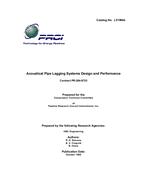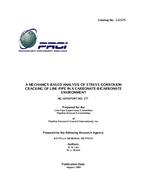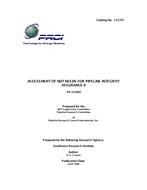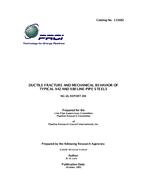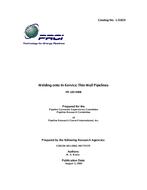Provide PDF Format
PRCI PR-264-9725
- Acoustical Pipe Lagging Systems Design and Performance
- Report / Survey by Pipeline Research Council International, 10/01/1998
- Publisher: PRCI
$48.00$95.00
L51960e
HBC Engineering
Need: Noise levels radiated from the exterior of a pipe wall can significantly contribute to the overall noise levels on the site of a gas plant and at neighboring properties. The noise inside the piping is generated both by the gas compressor itself, and by the flow of gas through valves, elbows and fittings. Sound inside the pipe couples to the pipe wall by exciting vibration modes, some of which are radiated from the exterior of the pipe into the air. Piping is geometrically circular, which provides it with considerable increased stiffness versus a flat plate, and thereby assists in its ability to contain low frequency sound inside the pipe. At high frequencies, where the wavelength of sound is short compared to the dimensions of the pipe, the response of the pipe approaches that of a flat plate, and considerably more sound is transmitted. Between the low and high frequency ranges lies the ring frequency, at which the wavelength of sound is equal to the circumference of the pipe; at this resonant frequency, a maximum amount of noise is transmitted out the pipe wall. For smaller pipe sizes, the ring frequency occurs above 5 kHz. For larger pipe sizes on the order of 24 inches to 36 inches, the ring frequency occurs in the range 1 kHz to 3 kHz. These frequencies fall in the most audible range of the sound spectrum. Low frequency sound is not usually of concern for pipe radiated noise, unless the source generates considerably low frequency energy.
Result: Acoustical lagging systems typically include one or more layers of porous insulation, to absorb sound and decouple vibration, and one or more layers of an impervious, heavy barrier material to contain the sound. The test configurations for this study were based on systems reported as commonly being used by PRCI member companies. Most of the member companies use fixed-in-place lagging configurations in which the various materials are applied in discrete layers to the pipe during installation. Self-contained, removable blanket systems are also in use by some member companies instead of fixed-in-place configurations, or around equipment such as valves where periodic removal of the lagging is necessary.
Benefit: This study provides a review of Acoustic lagging systems for above ground gas piping to minimize noise.
HBC Engineering
Need: Noise levels radiated from the exterior of a pipe wall can significantly contribute to the overall noise levels on the site of a gas plant and at neighboring properties. The noise inside the piping is generated both by the gas compressor itself, and by the flow of gas through valves, elbows and fittings. Sound inside the pipe couples to the pipe wall by exciting vibration modes, some of which are radiated from the exterior of the pipe into the air. Piping is geometrically circular, which provides it with considerable increased stiffness versus a flat plate, and thereby assists in its ability to contain low frequency sound inside the pipe. At high frequencies, where the wavelength of sound is short compared to the dimensions of the pipe, the response of the pipe approaches that of a flat plate, and considerably more sound is transmitted. Between the low and high frequency ranges lies the ring frequency, at which the wavelength of sound is equal to the circumference of the pipe; at this resonant frequency, a maximum amount of noise is transmitted out the pipe wall. For smaller pipe sizes, the ring frequency occurs above 5 kHz. For larger pipe sizes on the order of 24 inches to 36 inches, the ring frequency occurs in the range 1 kHz to 3 kHz. These frequencies fall in the most audible range of the sound spectrum. Low frequency sound is not usually of concern for pipe radiated noise, unless the source generates considerably low frequency energy.
Result: Acoustical lagging systems typically include one or more layers of porous insulation, to absorb sound and decouple vibration, and one or more layers of an impervious, heavy barrier material to contain the sound. The test configurations for this study were based on systems reported as commonly being used by PRCI member companies. Most of the member companies use fixed-in-place lagging configurations in which the various materials are applied in discrete layers to the pipe during installation. Self-contained, removable blanket systems are also in use by some member companies instead of fixed-in-place configurations, or around equipment such as valves where periodic removal of the lagging is necessary.
Benefit: This study provides a review of Acoustic lagging systems for above ground gas piping to minimize noise.
Related Products
PRCI Report 177
Mechanics-Based Analysis of Stress-Corrosion Cracking of Line-Pipe in a Carbonate-Bicarbonate Enviro..
$175.00 $349.00

